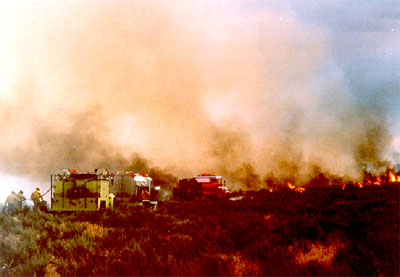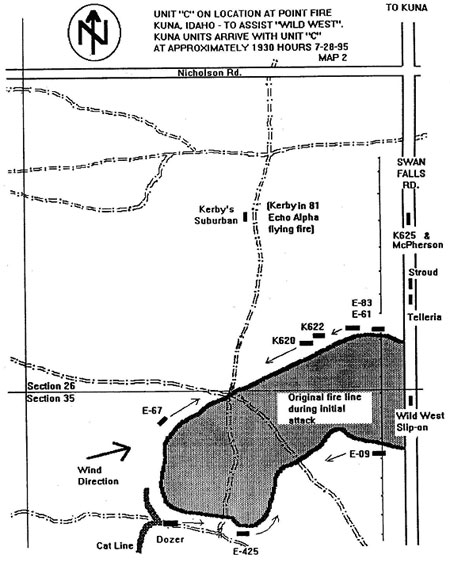
Point Fire, 1995
&
Island Fork Fire, 1999
dedication
Point Fire Case Study
Point Fire Accident Investigation
A. Point Fire Overview
B. Investigation
C. Recommendations
D. Supporting Data
- Sequence of Events
- Organization Charts
- Site Investigation
- Fire Behavior Report
- Property Damage Report
- Witness Statements
- Outline of Kuna Wildland Training Provided by BLM
E. Records and Reports
- Preplanned Dispatch
- BLM Radio Transmission Log
- Ada County Dispatch Log
- Fire Incident Status Summary
- Escaped Fire Situation Analysis
- Wildland Fire Entrapment Report
- Technical Analysis of Personal Protective Equipment
- Vehicle Inspection
- Weather Reports
F. Glossary
——————
Island Fork Fire Accident Investigation
——————
Point Fire — U.S. District Court Civil Case
Ruling on I.C.'s Decisions - Nov. 10, 1998
• Factual Background
• Legal Analysis
Ruling on BLM Liability - Feb. 19, 1999
• Findings
of Fact
• Legal Standards
• Analysis
Ruling on Public Safety Officer Benefits
(PSOB)
——————
——————
Colorado Firecamp extends special thanks to Linda Perkins, BLM
Idaho State FOIA Coordinator, for her friendly assistance in gathering
the Point Fire documents. BLM FOIA Letter
|
POINT
FIRE
ACCIDENT INVESTIGATION
Point Fire Overview
Date of Incident: July 28, 1995
Time of Incident: 1829 MDT
Incident Name: Point Fire
Legal Description of Location: T1N R1W Section 35 SE1/4 NW1/4
Late in the afternoon of July 28, 1995, thunderstorms began to move into
southwestern Idaho from northern Nevada. The thunderstorms produced little
or no moisture, and the lightning associated with them sparked dozens
of wildfires.
At 1829, the Danskin Lookout reported a wildfire northeast of Initial
Point, about 16 miles southwest of Boise, Idaho. The wildfire was also
reported by several citizens and the Ada County Dispatch Center. At 1831,
the Bureau of Land Management’s Boise District Dispatch sent the
“Wild West” Unit to the wildfire. The Wild West Unit consists
of two “type 4X” wildland engines (Engine 67 and Salmon District
Engine 425) and a “type 6X” slip-on. The crew boss, [————]
[————], drove to the wildfire in a Suburban.
More resources soon were dispatched. BLM’s “Unit C”
included three “type 4X” engines (Engine 09, Engine 83 and
Boise National Forest Engine E-61) and a Suburban driven by unit leader
[————] [————]. Additionally,
one “type 2” water tender and a transport with a bulldozer
were sent.
The Wild West Unit was the first to arrive on the scene at about 1900.
Crew boss [————] assumed the role of Incident
Commander (IC).
The Point Fire was actively burning in sagebrush and cheatgrass with
moderate rates of spread and 3 to 5 foot flame lengths along the flanks.
Because of higher-than-normal spring moisture, cheatgrass growth was especially
dense, estimated in excess of 3,000 pounds per acre. Mature sagebrush
from 3 to 4 feet high also added to the fuel load. The fire size when
the Wild West Unit arrived was estimated at 60 to 65 acres. Winds were
generally from the west at 4 to 6 miles per hour.
[————] was contacted by Boise BLM Dispatch and
asked if the Kuna Rural Fire District (Kuna RFD) was on the scene. [————]
said that he had not seen any rural fire department equipment or personnel.
[————] was then contacted by Kuna Fire Chief [————]
[————] and asked if assistance was needed. The
BLM IC replied that he could use a brush truck and a water tender. At
1907, [————] radioed Ada County Dispatch and requested
three vehicles to respond. Kuna Engine 620, a 1,500 gallon brush truck,
Kuna Engine 622, a 1,750 gallon brush truck, and a 2,500 gallon water
tender (625) responded. The Kuna vehicles departed from their fire stations
at 1911 for the wildfire.
The Wild West Unit arrived at the southeast corner of the wildfire on
Swan Falls Road, a two-lane paved road running north-south. Its initial
strategy was to keep the fire from crossing Swan Falls Road to the east,
and to minimize the loss of resources and property in the Snake River
Birds of Prey National Conservation Area. (See Map #1.) The IC tactically
positioned the type 6X slip-on along Swan Falls Road. The assignment was
to burn out along the road to keep the fire from crossing it. Engine 67
and 425 followed the IC to an area near the fire’s point of origin
at the southwest corner.
The engine crews were instructed to anchor and split up and directly
attack the flanks, using water pumper through their hoses, called “live
reels.” Engine 425 worked the southern flank east toward Swan Falls
Road, while Engine 67 worked the northern flank eastward, also toward
Swan Falls Road. Shortly after the flanking operation began, the BLM dozer
arrived and was assigned to work the southern flank, constructing a line
behind Engine 425 to the east.
A helicopter departed the Boise airport at 1857 enroute to the Point
Fire. The helicopter picked up the IC for a reconnaissance flight. During
the flight, BLM Unit C arrived on the scene along Swan Falls Road. Two
of the Unit C engines, 61 and 83, were assigned to directly attack the
northern flank, west from Swan Falls Road. Engine 09 was sent to directly
attack the southern flank west from Swan Falls Road. [————]
, the Unit C leader, assisted the type 6X Wild West slip-on with securing
Swan Falls Road.
Kuna RFD Engines 620, 622 and 625 arrived just behind Unit C at about
1930. The brush trucks were assigned to work behind Engines 61 and 83.
[————] [————], the Kuna
[————], came to the scene on Engine 620 and was
dropped off on Swan Falls Road at Tender 625 to act a Kuna Command, as
directed by [————] [————].

In the early stages
of the fire, the two Kuna RFD engines and two BLM engines worked the
north flank of the fire.
Shortly thereafter, Engine 61 and Engine 83 began flanking the north
line, working west from Swan Falls Road. Kuna 620 and 622 drove around
them in tandem and 620 began working a flare-up on the fire line, using
nozzles attached to the front bumper while driving next to the fire’s
edge. Engine 622 trailed Engine 620, conserving water. (See map #2.)

Map #2
At 2010, [————] stated that engines on both flanks
had met and the spread of the fire had been stopped. He estimated the
size of the fire at 120 acres. The dozer continued working the southern
edge toward Swan Falls Road.
<<< continue
reading—Point Fire Investigation, Red Flag Warning >>>
|